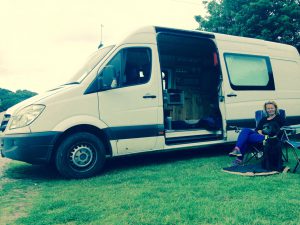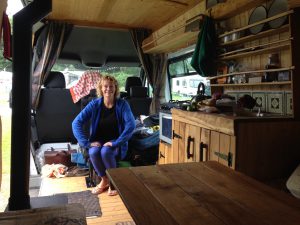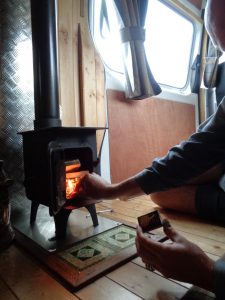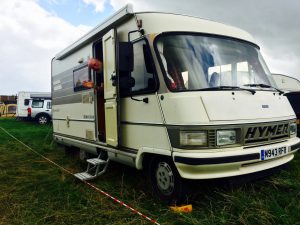The hard part.
How much will it cost to fulfil your dream?
How much do you need on the road?
I grew up in a family where it was considered rude to talk about money. What a shame.
Thankfully now it’s easier to access financial details on any number of things. Here I’ll share a few thoughts with you on the cost of vans and the cost of living on the road.
A generous budget. This is article not for folk looking to travel on a tight budget – although van life certainly offers that as an option.
We have worked at some crazy hard jobs for 30 years, usually juggling full time work with running our own business. Because of that we’re in the fortunate position of being able to tackle van life with a generous budget.
At the other end of the scale, for a young family who can just scrape together the funds for a basic van it’s still a great choice and will probably help bond and positively shape their lives in a way that no other holidays can.
Van v MoHo. First up you need to decide what you want to travel in.
Is it a van conversion that’ll be the vehicle to your new found freedom?
Or do you feel the pull of that wide panoramic screen and those deep luxurious seats in a motor home?
Our section Van v MoHo will take you through some of the decision making processes we employed to answer this vital question – but remember your needs will be different.
We knew from the outset that we favoured a van conversion and we started off looking at modestly priced conversions on a number of sites.
AutoTrader’s dedicated motorhomes site is probably the easiest to use. A quick look as I’m writing brings up great looking van conversions priced between £8k and £65k, with motor homes between £3k and £295k.
Yes – £295k! We haven’t yet had to pay that for a house! Reading the description of the 8.8 litre beast my first thought was to wonder how many miles to the gallon it manages… I suspect it’s not for me.
Budgeting our base van. Like any good building project we started with a figure that we thought was the absolute maximum we could spend, and then watched the costs spiral up.
Once we’d chosen our base vehicle, the VW Crafter, we worked out where we thought the sweet spot was between mileage, age and price.
The 2017 Crafter has already been unveiled, but we couldn’t stretch to that, even though it’s certainly a beauty.
A new Crafter, even in our shape, was going to cost at least £35k and that’s before you start on the extensive options list. Targeting a two year old vehicle with around 20,000 miles we hoped to buy at around £15k, or less than half its new price.
We eventually found Archie after much boring searching – the trouble is they all look the same, there are hardly even any colour choices.
Importantly he had the most powerful 163bhp bi-turbo engine. That extra power makes for more relaxing driving, as well as better economy.
What he didn’t have was air-conditioning and I’m sure we’ll come to regret that as we head south. After market air con options look very expensive, but in my defence I only saw a couple of very expensive vans that did have it when I was looking.
Budget for the conversion. If you can do the work yourself then you’re laughing – remember the cost of your own time, but then get on with it.
We had no intention of doing the work ourselves. We were completely happy working out the design, but that was where we hoped our efforts would stop.
We created our (long) wish list of what the van had to be capable of, and then went in search of a builder.
Although I had quotes from very different companies using different materials yet all came out at around £25k.
Ouch!
The physical items you need are very expensive, heating, cooking, cooling and the like all cost far more in their miniature form than a full sized house version.
I felt a little better admiring a 4×4 conversion and finding out that the German owners had spent close to £90k before starting on the insides!
Can you do it cheaper? The simple answer is “yes”.
There are all sorts of ways to cut corners, the obvious one being to buy someone else’s conversion – but always ask yourself why they’re selling it on.
£10k will get you a great second hand conversion. Something like Constance, the first van conversion we hired, probably cost about that. There’s no insulation, shower or toilet, but it does have a wood burner and a hand made Welsh dresser!




£13k will get you The Moog right now (the Moog sold quickly and it’s now in good and excited new owner’s hands). It’s a wonderfully well designed 1994 Hymer that we hired while waiting for Archie to be finished. Its owner lived and travelled in the van over 12 months while rebuilding his house but now needs to recoup some of his costs.
The Moog takes some effort to drive, but you soon get used to it. It easily makes up for that effort by being a comfortable beast to live in with seats and sleeping for four.

How much do you need on the road?
Track your spending – if you don’t it’ll run away with itself and you’ll be left feeling bitter about the sums that have disappeared without trace.
This will depend entirely on your life style and the distance you want to travel.
So that you can create your own spreadsheet to help your calculations here are the things we’ve budgeted for – you’ll see from this that we intend to live well, but we can see at a glance where we can shave costs when we need to.
Your biggest costs are likely to be:
- Fuel – drive slower and drive less to reduce! Keeping Archie’s speed under 70mph makes a big difference to his consumption. We have budgeted on driving 50 miles a day, but hope that it’ll be mostly occasional long drives rather than actual daily amounts.
- Sites – wild camping isn’t always allowed (not at all in Slovenia, and in fact in the UK it’s more tolerated than allowed as all of our land is owned by someone). Not only that but the less hardy of us may yearn for the comfort of a good camp site now and then. It’s certainly a good option for easily keeping on top of your laundry. My 2017 European trip saw me paying between £9 and £38 a night and so I’ve made allowances based on £20 a night. £38 was in Paris and given the quality and location of the site it was worth it.
After that we’ve allowed for some luxury.
- Hotel stays – yes, call me soft, but every now and then if we see a great hotel we hope to be able to stay there and we’ve budgeted to do so once or twice a month.
- Eating out – again, this life on the road isn’t planned to be hard for us. While we’ll cook most of the time, and enjoy doing so, we’ll also eat out now and then. After all you know what it’s like, you’ve had a bottle of a fine local wine and suddenly the next table’s dinner looks a whole lot more tempting than going back to cook from scratch.
Unavoidable costs.
- Insurance – travel and vehicle, maybe pet too
- Maintenance – have a fund for it and it won’t hurt as much when something needs doing
- Tolls and vignettes – those fast roads are getting more expensive to use, but cut time dramatically when you have a distance to cover
- Mobiles and internet – I’ll write more on this when I have experience. Currently my generous data package from EE has covered all my phone and data needs
- Costs back home – and don’t forget that if you are leaving a home in the UK, even if its rented out, you’ll have some costs to cover there too
- Spending money – I hope we won’t need much more, but it’s worth having an allowance.
For a more detailed cost breakdown, and one that’s done on a fairly tight budget have a look at the excellent Our Bumble blog.
